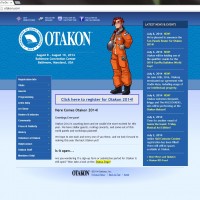Eva Monkey Panels for Otakon 2014
By The Eva Monkey on Wednesday, July 9th, 2014
 Otakon has released the official roster of fan panels for this year’s event. I’m pleased to be hosting two panels this year, for what will be my twelfth consecutive year as a fan panelist. It’s hard to believe I’ve been doing them every year since Otakon first incorporated fan panels in 2003. This year’s installment in Evangelion focused on the many ways in which Evangelion, a cartoon, has invaded the public consciousness. The various examples run the gamut from good, to bad, to ugly. Here’s the full panel description:
Otakon has released the official roster of fan panels for this year’s event. I’m pleased to be hosting two panels this year, for what will be my twelfth consecutive year as a fan panelist. It’s hard to believe I’ve been doing them every year since Otakon first incorporated fan panels in 2003. This year’s installment in Evangelion focused on the many ways in which Evangelion, a cartoon, has invaded the public consciousness. The various examples run the gamut from good, to bad, to ugly. Here’s the full panel description:
Japan Loves Evangelion (Entirely Too Much)
At some point, Evangelion graduated from a controversial, yet successful television series to iconography that has pervaded Japan’s relatively conservative culture in a variety of interesting and unexpected ways. From promotional tie-ins with Pizza Hut, Doritos, and Shick, to an entire Evangelion-themed attraction at the Fuji-Q Highland amusement park, there is no doubt that Evangelion has invaded Japan’s public consciousness. And that’s saying nothing of the breadth of merchandise that has been produced over the past two decades. Attire, electronics, sporting goods, housewares… you name it, they’ve probably slapped a Nerv logo or a relevant color scheme on it at some point. We’ll be taking a look at the many ways that prove beyond the shadow of a doubt that Japan loves Evangelion entirely too much.
Also, if you happen to be a fan of old-school gaming and it’s dramatic and occasionally hilarious history, consider checking out my panel about Sega:
Sega does… what Nintendon’t.
After the video game industry crash of 1983, Nintendo was able to explode onto the scene and secure the vast majority of the market, and it remained largely unchallenged until the early 1990s when Sega gained a foothold with the Sega Genesis and games like Sonic the Hedgehog. What followed was the infamous “bit wars” between Nintendo and Sega, an at times childish back-and-forth that has ingrained itself into the collective memory of gaming. We’ll take a look at the history of Sega, how it became a serious competitor to Nintendo, where it went wrong, and how it all fell apart. We’ll look at its well-known blunders with hardware, as well as the advertising and marketing that ranged from absurd to just plain “what were they thinking” weird.